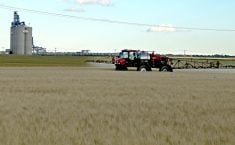HANNOVER, Germany — Poor rural connectivity is a fly in the ointment for ag tech companies.
The power of machine learning and cloud computing will only be completely unleashed to help farmers once broadband internet becomes available out in the field.
Low power, wide area (LPWA) networks have been installed and used successfully in cases with light information demands, including internet of things devices that monitor weather and soil moisture and keep track of livestock.
But for situations involving high data needs, there are few options for farmers.
Read Also

House ag committee to undertake several studies
The House of Commons standing agriculture committee has set its agenda for the coming months. Members began the fall sitting with a two-hour update on international trade
John Deere is challenged by poor rural connectivity as it develops its next generation of farm equipment.
The company equips its seeders, sprayers, and harvesters with LTE for rapid cloud transfers but many of its touted technologies for the future require high speed internet.
For instance, its tractor cab of the future can monitor and control multiple semi-autonomous machines at the same time. As well, its autonomous platforms require constant connectivity.
John Deere has invested in 5G technology, but it hasn’t defined how or when these services will be available to growers.
At Agritechnica, however, it gave a glimpse of one possible solution that may connect the smart farm of the future — Rural Connectivity.
“This station is a solution of setting up your own private, LTE, 4G, and in the future 5G network to fix that coverage so you can use your connected farming services or anything like that in the field,” said Martin Stauch of John Deere.
He said Rural Connectivity is similar to a product the company launched in Brazil two years ago, which uses a fixed tower and is connected via a fibre optic digital subscriber line (DSL).
But the network base-station prototype shown at Agritechnica connects to the internet via a satellite antenna, and can be moved to where it’s needed because it sits in the back of a pick-up truck.
“You can take the box with your truck out in the field, when you start working in the morning,” Stauch said.
“When you’re finished with your work, you can take it back, and then the next day you can put it on another field.”
The station has a tower that is erected once the truck is in position, and it’s powered by an onboard battery and generator.
“For this solution, we have a quite high frequency we are sending in so the range is limited from three to five kilometres,” Stauch said.
He said the station is currently equipped with 4.5G technology because true 5G components aren’t yet available.
Stauch said he is unsure when Rural Connectivity will be available for North American farmers or how much it will cost.
Contact robin.booker@producer.com


















